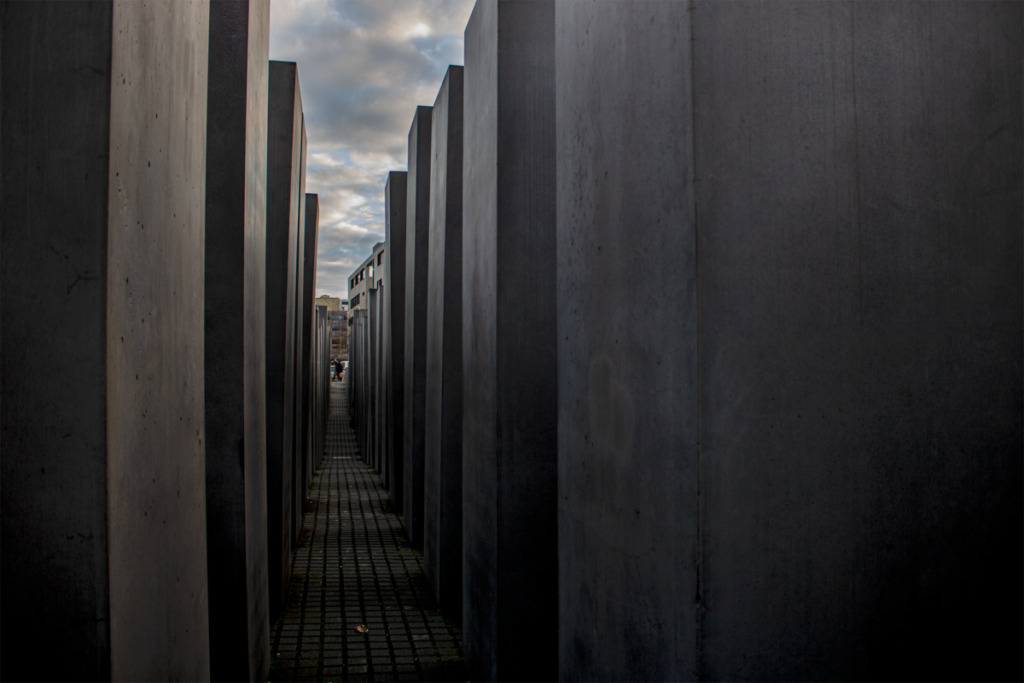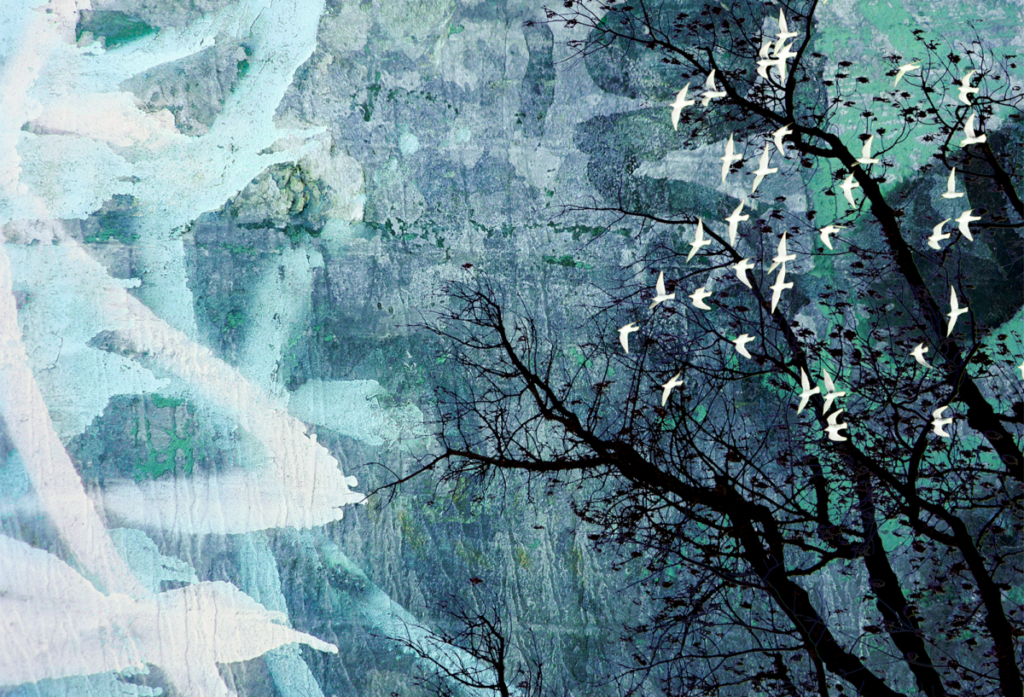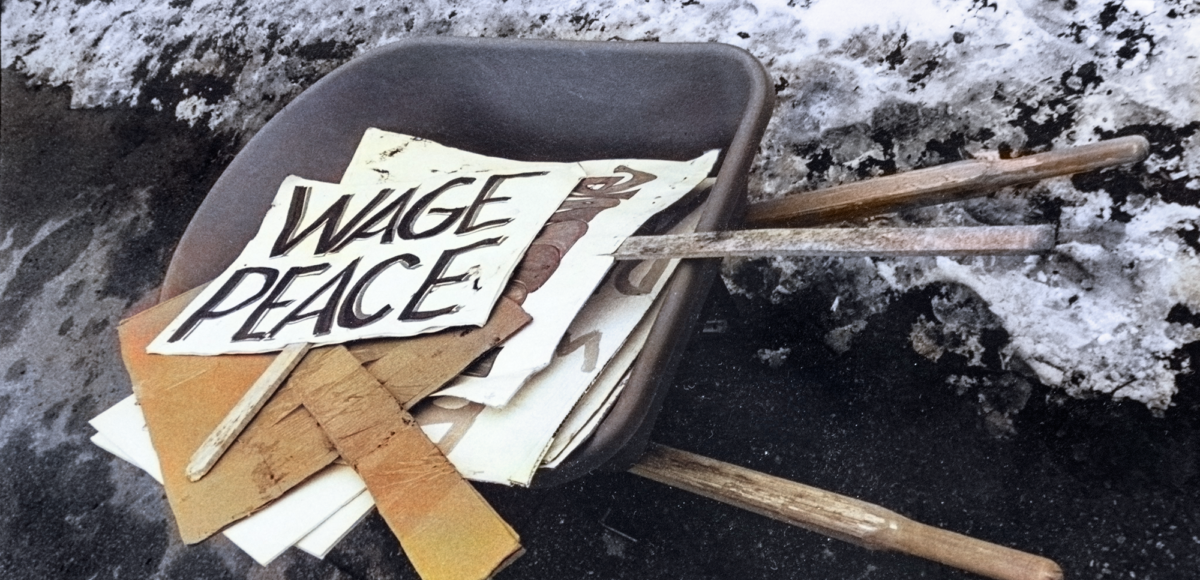Untitled, David Wiinikka-Lydon
President Trump declared war on the novel coronavirus, the source of COVID-19, as early as April 2020, when it became clear that this new disease was no passing plague. His was a call that many took up, not only in small towns but also major media outlets,1 which compared the death toll of the pandemic to that of previous U.S. wars.2 The invocation of such a metaphor, however, immediately inspired critique,3 and posed questions about the ways in which we approach national and even global crises as a country.
The United States, of course, is not at war. At least, it is not at war against a coronavirus. The administration was employing, or really deploying, a metaphor. It is a metaphor that is central to U.S. identity, one that has become the default in framing moments of national import, to sway public opinion and so accumulate power, and to galvanize the capacities of the U.S. society and economy behind a political goal. At least since World War II, war has arisen to dominate the U.S. political imagination when politicians seek to mobilize the country behind a specific agenda. The War on Poverty, the War on Drugs, the War on Terror - war is the metaphor of choice for the United States when trying to understand, as well as manipulate, crises.
The use of the metaphor and images of warfare to frame, and I would argue, constrain our understanding of this pandemic not only undermines the ways in which we respond to this crisis but strengthens politics that fear liberative ethics.
It blunts our imaginations and our ability, at least collectively in mainstream discourse, to recognize the reality of the crisis and the needs of those within it. This war, after all, is no war. It is a pandemic. These viruses have not launched a war on us, do not even know who “we” are, and the only casualties are our own. Indeed, there is something ridiculous, and ridiculously epic, about framing such a pandemic in terms of war. Such a war’s asymmetry, where the most powerful military in history, a somewhat universal presence spread across the globe, is pitted against an entity that is conspicuously local, and miniscule, just a micron’s length in size, would be comic, if so much were not at stake.
This is not to make light of the seriousness of the pandemic. Instead, it is an argument that in order to engage the current crisis, it is important to engage it as the crisis that it is. Teasing out the image of a geopolitical Goliath versus a microscopic David calls the bluff that is at the heart of such a war metaphor. Such metaphors are no help as we try to better understand the nature of the crisis, and so better counter it. Instead, they serve as a means to replace the pandemic with a crisis more malleable in the hands of political leaders, one that allows opportunities to highjack the crisis and use it as a basis of power and an avenue to shirk accountability.
We are susceptible to the metaphor of war not because it is the best way of viewing this crisis, nor because it is the best way to quickly mobilize such a large country. It is, instead, a consequence of a limited and limiting shared political imagination.
It is a wizened imagination that serves the desires of a few while eliding the needs of the many. Our imaginations and the metaphors at our disposal have become impoverished, so much so that it is now hard to imagine what public, mainstream conversations that took social welfare and anti-militarism seriously would even look like.
The starved resources for moral and political imagination is a profound constraint for collective and common agency and solidarity. The way we look at the world, the way we imagine various futures with some, without others, provides the imaginal ground on which we understand what is possible and what is not, and what its is even possible to imagine. So much of imagination itself is built on metaphor, that dialectical structure through which we associate different, disparate objects and vistas and make the leap to new insight. To say, for example, that the United States is war, to paraphrase Sora Han, creates the possibility of seeing the United States, as well as war, in a whole new light, opening us up to new images, new evaluations, and the potential for new action that did not exist before.

Metaphors and imagination, then, not only liberate; they can also constrain agency, the ability to affect the lives of others through one’s actions. In particular, it is how rich or poor the common well from which our imaginations drink that either support more liberatory or more constrained agency. The availability of various metaphors affects our range of action, evaluation, and imagination, constraining possibility through the availability of images and metaphors. The dominance of war as a metaphor in mainstream discourse, a dominance over how we analyze issues that are spread across disparate and quite distinct spheres of shared life, has made it difficult, then, to frame and so understand the present, constraining the options one believes they have to act. The futures we believe we can work toward are constrained by those futures we can collectively imagine.
As awful and profound as this pandemic is, it is apocalyptic in the literal sense of a “revealing.” The pandemic has forced more people to see, or at least created space for them to truly acknowledge, the fundamental economic reality of our society and that less than virtuous labor regimes exist in the United States.
An aporia has opened, to take a term from philosophy, that is both an opportunity for change but also a cause for anxiety. Anxiety, as revelations that our economic relationships, on which the identity of Americanness is partially built, are not virtuous but vicious undermines the moral exceptionalism of the U.S. narrative. This means that this aporia, and such dissonance between account and reality, must be sealed off, must be resolved, unless one own the untenable suggestion that U.S. history and economy are vicious, at least in some ways. This exposed wound that has opened is sealed once more by adding more labor onto such workers and communities, that is, the very labor of shoring up the viciousness of our social and economic arrangements through the virtuous sacrifice by showing up for work. Those that do not, such as those who tried to organize workers at Amazon who were being exposed to COVID through their jobs, risk highlighting the lack of virtue in U.S. capitalism, which is supposed to be one of the key pillars of our country’s moral exceptionalism. They become as dangerous as the virus and are placed in the category of the vicious.4
What we need, then, are better metaphors that can transform the way we interpret our world and what is possible. We need metaphors beyond those of war, metaphors that can help us see the current situation better, metaphors that allow us to expand what is actually possible for us to do together both now and into the future. The metaphor of war is so problematic because it only appears to create the unity we require. In actuality it divides us and props up unjust and inequitable systems and social relationships. What will always be fascinating is how constraint, whether in performance, art, or ethics, can act as a creative limit against which new horizons and possibilities are imagined and achieved. Indeed, this is not just a moment of dismal revelation. There are in the air images and discourses that are potentially liberatory. The constraint of such deployed metaphors and their accompanying virtue language have been flipped in the very midst of the war on the virus. With the killing of George Floyd, a counter narrative has arisen, the insistence that black lives matter, as well. This is not only because of the black lives matter movement, of course. It is also due to the president’s incompetence as a “wartime” leader. But this movement, broadly conceived, must be recognized as subverting the idea, reinscribed during the early months of the pandemic, that the country was united under the commander-in-chief and that war would define who and what actions would be considered virtuous and vicious.
In the place of a metaphor, or really a simile, of the pandemic as war was inserted the imperative, “black lives matter.” Although metaphors are part of this movement, the unequivocal assertion of that phrase has cut through the metaphorical haze that has been deployed in response to the pandemic.
It is itself a gift to the rest of the country on so many levels, but also on this: it has interrupted a tried and true narrative used to suppress critical analysis and liberative action under the claimed hyper-threat of war. And in its wake, new metaphors can be asserted that can hopefully renourish our shared moral imagination.
Indeed, how quickly the call to war has faded from public discourse. How quickly, too, it has faded from the president’s lips. Since the resurgence of black lives as a rallying cry in 2020, and the failure of his approach to leadership during the pandemic became clear, the president has, in reaction to the protests and uprisings, largely abandoned the wartime metaphor and doubled down instead on another well-known script, that of law and order. He has moved from the metaphor of war to actual violence, employing border guards and other federal agents congealed into the Department of Homeland Security to launch attacks on protestors in Washington, DC, and Portland, Oregon. (The president has also promised to expand this to other cities that did not and will not vote for him.) Metaphors still hold, but something of a pretense has been shattered, or at least cracked. The former unity professed under COVID through the evocation of war has transformed through presidential action into a full-fledged campaign of division through the organs of domestic state violence.
The enemy is no longer a microscopic virus. The enemy is revealed instead to be those who will not get with the program, who will not be re-ordered under this law and order rubric.
The pandemic itself has also created constraints, and continues to do so, creating even more risk for those who feel the need to protest against the death of black lives against toxic police cultures that decades of politically negligent decisions have grown. It is no easy thing to create such a moment of protest and what amounts to a political re-imagination in real time on the streets when doctors warn that we all need to stay in doors for the safety of all. It is a very real restraint to have to yell through a mask, yet another to have to battle for dignity and life, on the one hand, when, on the other, that very battle ends up threatening life during a pandemic. How can one’s voices be heard by others when the very act of being outside in order to protest is at once ethically imperative but, seemingly, also irresponsible?
In the midst of this, however, the pandemic also created an opening. It interrupted the everyday routines and ways of living and relating to others that are themselves perhaps the greatest restraints to social and political transformation. Every day so many of us, including the white, cisgender author of this piece, practice over and over not changing the status quo, not letting the grievances of others in our society shake us awake. This is not a choice so much as a habitus, to take a term from Pierre Bourdieu, the institutional, shared lives in which our moral imaginations are conditioned and constrained. The pandemic, however, disrupted the matrix of institutional life in which we all live. Many middle Americans that seem to be the lynchpin to U.S. politics and policy no longer could live the lives they lived, having instead to adopt new practices. Work was transformed, labor discussed and contested. For some, they simply had to sit and wait. Phrases such as “white supremacy” and “defund the police” were uttered on the evening news. Many will in the following decades analyze the profound shift such disruption of daily practice and institutional life created in the United States. Make no mistake, however. This has created and continues to create a moment, an opening, where change was made possible because it was no longer possible to practice what had become standard, virtuous American life.

Thankfully, those protesting, and the activists and movements that laid the groundwork for such protests to happen and to endure, have done something with that opening. They are helping push back an old imaginary where war has become the only thing that the United States can do well and together. Through this metaphor activists of color tore a hole, and a hole it has remained, one large enough to drive through the point that some lives matter less than others in this country and that such an immoral reality should not stand. The metaphor was replaced with an imperative and an injunction that black lives matter. To that we could add other lives as well, but the unifying trope gestured to during the pandemic has proven insufficient to cover over the real and important grievances that have shone through during this year of profound crisis. This year, war was not enough to unify and silence. Instead, the long preparation of activists since Ferguson and beyond has given us a gift to perhaps begin reimagining our collective life and the way we relate to each other.
The metaphors that we need, and the new ways to imagine ourselves and what futures are even possible, will come from such movements – their art, their discourse, their bodily presence. These metaphors will not be entirely new, as they build on histories of past struggle, of histories not grounded in domination and competition, or at the very least, visions of the same. It is hard to predict what this imagination will look like, but it will be sharpened against images that show the United States as great only when it rallies for war. What we need to do is start looking for those new images, to search them out, and to broaden our range of accountability and response, as ethicist H. Richard Niebuhr encouraged us to do so many decades ago.
And we need to listen. The United States is diversifying quickly, and the way I and others like me imagine the world, having grown up white in a white majority country, will no longer be helpful in only a few decades time, when white bodies like mine tip from majority to plurality. The United States of the Cold War cannot be the model for how we should be in the future. At the same time, it would be to act against this future to assume I could put forward metaphors by myself, an assertion that would come from my maleness, my whiteness, and the cisnormativity I embody. Perhaps, instead, we can begin as the mystics begin with something like a via negativa to show what metaphors we must resist and ultimately abandon. What is said now in negation may lead soon to speech in a more affirming mode. And moving beyond imaginations that posit our collective existence in terms of scarcity, in terms of competition, of winners and losers, of every challenge as an act of war, we may find ourselves more dexterous in our engagements with the world. We may see one day that we are not greatest when we are at war.
Want to know more about this author? Click here!
Footnotes
- Paul Krugman, “How America Lost the War on Covid,” NY Times, accessed November 4, 2020, https://www.nytimes.com/2020/07/06/opinion/covid-19-trump.html
- David Welna, “Coronavirus has now Killed More Americans than Vietnam War,” NPR, accessed November 4, 2020, https://www.npr.org/sections/coronavirus-live-updates/2020/04/28/846701304/pandemic-death-toll-in-u-s-now-exceeds-vietnam-wars-u-s-fatalities.
- Ishaan Tharoor, “Are We at War with Coronavirus?” Washington Post, accessed November 4, 2020, https://www.washingtonpost.com/world/2020/04/06/are-we-war-with-coronavirus/.
- Mike Snider, “Leaked Memo: Amazon Strategy to Attack Staten Island Strike Organizer as ‘Not Smart,'” USA Today, accessed November 4, 2020, https://www.usatoday.com/story/money/business/2020/04/02/coronavirus-amazon-sought-discredit-labor-organizer-covid-19-worker-walkout/5116929002/.
